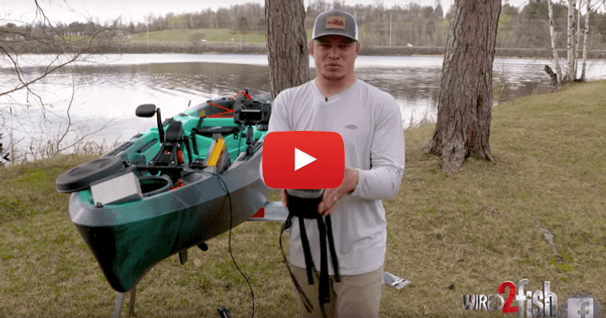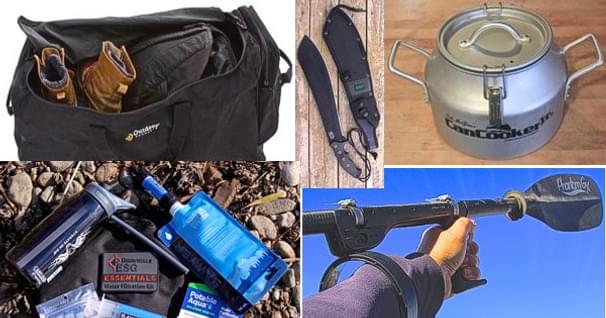The Joy of Paddling with a Voice-Controlled Camera
What would it take to make photographing from a kayak or canoe a pleasure?
~A Paddler's Post submitted by Gregg Jackson~
For decades I had combined the joys of hiking and photography, but when I became a regular paddler, photography interfered with the pleasures of the outings. It broke the meditative rhythm of the strokes; it required removing both hands from the paddle—my source of propulsion, steerage, and balance; the lack of control made the bow of the kayak drift unpredictable around in the image; and I worried about a good camera being destroyed by one unexpected splash.
So, I gave it up for two years but missed it, and finally thought to ask the question: “What would it take to make photographing from a kayak or canoe a pleasure?” The answer was a waterproof camera that could be mounted on my head and voice-controlled. After some searching, a GoPro Hero 8, the action cam darling of the daredevil set, which also takes still photos, seemed the best bet. With some hesitancy, I plunked down for one.
It’s so easy, and the results have been astonishing. I have been averaging about 120 shots per 2.5-hour paddle. At least half are keepers and 10 are impressive, often even in difficult light conditions. Several have an intimacy with nature that my hand-held shots usually lacked.
With the camera mounted on a head strap, here is the voice-controlled drill:
- “GoPro turn on”
- “GoPro take photo”
- “GoPro shoot burst” (several images in quick succession)
- “GoPro take photo”
- “GoPro turn off” (to conserve the battery)
Here are examples from the first month of use, unedited except for some cropping:
To maximize the joy, just paddle, look, and shoot. Go with that flow. The SuperPhoto option usually handles the exposure brilliantly. Don’t hassle with carefully framing the composition. With a very wide-angle lens and 6-8 MB files, you can always crop at home and still have a HD presentation. The great depth of field allows including a portion of your vessel in the image to add context, while leaving everything in focus.
Sound too good to be true? Well, in addition to buying a GoPro Hero 8 or GoPro Hero 9, it requires $40 of other gear with some home customization, learning the basic operations of these not-normal cameras, and overriding several of the default settings. Here’s how.
The Gear
As of Fall 2020, the Hero 8 was still available for sale at about $300, and the recently released Hero 9 costs a hundred more. The former is a little smaller and lighter than the later but has a 20% shorter battery life.
The GoPro brand head strap benefits from a few alternations shown below.
- Since you won’t be seeing the display screen, you need to assure the camera will be pointed directly ahead when you are looking that way. To facilitate that, a small strip of closed-cell foam rubber, 3/8” x 5/8,” has been sewn onto the strap where it passes through backplate to which the camera attaches, and the camera is rotated back until it is resting against the foam. It took addition of a small white wedge of additional foam to get the angle right.
- The standard thumbscrew protrudes into the paddler’s field of vision, which can be irritating, so it has been replaced with a metric M5-0.8 x 20 machine screw, preferably of stainless steel, available from some hardware stores and Amazon.
- While the Hero 8 and 9 are waterproof, they don’t float, so it is prudent to tether the head strap to one shoulder strap of your PDF. If there is nothing to clip onto, get a split ring used to hold keys, sew it onto the top of the strap, and clip onto that. Keep the tether as short as practical so that if the head strap slips off your head, the camera won’t bang against your vessel. Plastic snap clips are available from outdoor suppliers and Amazon.
- Since I like to paddle under tree branches protruding from the river shore, and there is always some risk of becoming entangled, a break-away link has been inserted between the tether and head strap. I used a quarter-inch strip cut from a silicone exercise band, but any UV-resistant material with 10-15 pounds tear strength will work.
If you will be putting the head strap on when you are away from the mirrors of your car, a small plastic mirror, such as Coghlan's Featherweight Mirror, is important for checking the alignment on your head. The head strap has grippy material on the underside and has not slipped out of position during my use, but if you have long hair, it might be wise to pull it back securely.
Most paddling hats will block the upper portion of the pictures. I use a thin wicking beanie from Amazon for UV protection. First put on the harness, with the camera mounted but rotated forward some; then put on the beanie, pulling it over the foam strip mentioned in #1 above and down as far as it will go easily; smooth the beanie; and finally rotate the camera back against the beanie and foam. Baseball caps worn backwards will probably work.
Warning: Shooting with this rig when paddling into an unobstructed sun could fry your eyeballs, even when wearing sunglasses. Use clouds or shore foliage to diffuse the fireball.
Finger prints, raindrops, and splashes will wreck your images. When not in use, store the camera and headband in a small plastic storage container with flip locks and an elastic band as extra precaution. A one-liter Sistema that is 6.5” x 4” x 2.7” works well for the folded head strap with the camera attached, but there are many similar ones. Place the camera in so that the strap and tether clip won’t rub against the lens. Avoid using the camera in rain or when paddling into strong winds, which will blow water drops off your paddle. Light fog is not a problem.
Camera Settings
For general guidance in using the Hero 8 or 9, see the online GoPro “Product Manual,” the many videos on the web, and/or Jordan Hetrick’s books. Here are the special settings used for all the photos in this article:
- Mode: Photo
- Lens: Linear (to minimize fish-eye effect of the very wide lens)
- Photo Linear: Photo: Output: SuperPhoto (for very smart auto-exposure)
Dashboard:
- Voice Control: On
- Camera Beep: On (confirms that voice commands have been executed)
- QuickCapture: Off
- Screen Lock: On (to prevent inadvertent modifications)
- Orientation: Landscape: Locked
Preferences:
- Connections: Wireless Connections: Off (to extend battery life)
- General: Auto Power Off: Never (to prevent automatic shut-off]
- Voice Control: On
- Wake on Voice: On (allows voice to turn camera almost “Off” to extend batterylife & then back “On”)
- Regional: GPS: Off (to extend battery life)
Final Observations
Rather than distracting from my paddling pleasure, this approach to photography has enhanced it—attuning my eye to the surroundings and effortlessly capturing the beauty. During winter daydreaming, I’ll have the photos to click through.
If you hate hassling with your smart phone and computer, you probably should avoid a GoPro. Any tech-savvy 12-year-old could help you, but once they get their hands on the camera, you’ll probably never see it again.
With a head strap rig, it is difficult to keep the horizon perfectly level. If you are not into photo-editing, use Microsoft’s free and super-simple Photo app to "Edit: Straighten" and then save to a modified file name.
When you want a portion of your kayak or canoe in the image, include somewhat more than just the bow, and head the vessel a little to one side so that it doesn’t stiffly bisect the image. To keep the paddle blades out of the image, momentarily pull the paddle shaft to your waist. If you want a blade in the image, understand that there is some shutter delay after you give the command, “GoPro take photo” and hear the confirmation beep.
So, why not take videos with a camera designed for that? Flat-water voyaging videos quickly become boring, even with sublime scenery. The images change too slowly. Instead, I will make slide shows with the highlights of a trip. Friends can click through a dozen images in 30 seconds, say “nice!” and move on with their lives.
Disclosure: The author does not work for GoPro, receive free equipment, or own stock in the company—regrettably.
Did you know this article was a Paddler's Post submitted by one of your fellow paddlers?
Submit your own epic paddling tale, paddling lesson, or helpful tip and share with the community!
Related Articles
Learn how to install a fish finder on your fishing kayak without compromising your yak by drilling holes…
Earlier this month, I was given the opportunity to travel to Glover’s Reef Atoll - a protected…
Each year the outdoor industry pulls back the curtain to showcase more and more "stuff" for us to drool…
7 out of 10 camera repair requests are because the camera got dropped, the other 3 are because the…














